Buying A Walk-In Bathtub – Your Biggest Mistake?
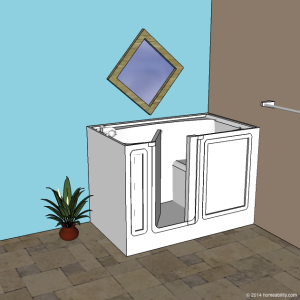
Walk-in bathtubs are often advertised as an “amazing” product for seniors and people with disabilities, with the claim being that this type of bathtub will maximize your ability to bathe safely and independently. But will this bathing solution truly deliver all the safety, convenience, and comfort you desire?
After all I’ve witnessed as an occupational therapist and home ability specialist, I would strongly urge potential buyers to proceed with caution, as there can be more inconveniences, safety risks and hidden costs present than apparent at first sight.
Common Misconceptions about Walk-in Bathtubs
The following paragraphs highlight common misconceptions about walk-in bathtubs:
Misconception 1
Walk-in bathtubs maximize bathing comfort & convenience.”
|
Reality |
There is an obvious – but surprisingly often overlooked – consequence of entering a bathtub through a door in the sidewall: You can’t prepare the bathtub full of hot water prior to climbing in and you cannot exit the tub until the water has fully drained out. To put this more bluntly – once you have stepped into the tub naked and pulled the door closed behind you, you could find yourself waiting up to 10 minutes or more for the water to rise slowly from your toes upwards. Then at the tail end of the bath, you could again be waiting as much as 10 minutes or more while sitting naked, cold and wet waiting for the tub to empty. Fill and drain times can vary greatly due to a combination of different factors, which include: your home’s water pressure, the tub’s drain type, and your home’s pre-existing plumbing.
Furthermore, it is good to be aware that most walk-in bathtubs are designed to hold a bather in an upright, seated position. If you are of an average or above average height, there is a good chance that only the lower half of your body will be fully submerged. So if you are envisioning warm water soothing your aching back, neck and shoulders, you are likely to be left feeling sorely disappointed. Bottom line: A satisfactory bathing experience? – Probably not! |
Misconception 2
Walk-in tubs substantially increase safety.”
|
Reality |
A Walk-in tub, as the name implies, requires you to be able to walk to enter the tub. In fact, you need to be able to walk fairly steadily because most walk-in tubs have a step you must raise your feet over and a narrow doorway to wiggle through. Furthermore, most models have a door which swings inwards. This in turn means you must have the skills to maneuver yourself around the door to shut it while you too are occupying the small space inside the tub. The Walk-in tubs equipped with inward-opening doors come with an even more glaring safety risk, namely that there is area real risk of finding oneself trapped inside. People can and have found themselves trapped inside of walk-in tubs with inward-opening doors — in some cases up to several days! Entrapment inside a walk-in tub with an inward-opening door can be caused due to a variety of reasons, which include: being unable to drain the water from the tub; a slip-related fall or a medical emergency. Keep reading to better understand how each of these scenarios can occur. People can and have found themselves trapped inside of a walk-in tub with an inward-opening door as a result of being unable to drain the water from the tub. It’s important here to note that when a walk-in tub with an inward-opening door is filled with water, the water exerts pressure on the door holding it firmly shut, making it impossible for most tub users to open the door when the tub is full of water. There are 3 reasons a person may be unable to drain the tub: an individual may be unable to activate the drain control due to slippery hands or insufficient hand strength, the drain control itself may malfunction, or the home’s plumbing may get backed up, preventing the water from exiting the tub. If the tub’s user is unable to climb over the three to four foot high tub walls, they will find themselves trapped inside. People can and have also experienced a slip-related fall and found themselves sitting in the tub’s footwell. When seated on the tub floor, their body acts like a door wedge blocking the inward-swinging door from being opened — effectively creating a tiny cage, which some people have been unable to escape from by themselves. It is also important to be aware that if a person experiences a heart attack or stroke while sitting on the seat of a tub with an inward-opening door (even if a fall does not occur), their legs and/or body will block the door from being opened. The combination of the inward-opening door and the high tub walls can make it extremely difficult for family or EMTs to rescue someone when a medical emergency or fall-related incident does occur. Bottom line: A safer bathing experience? – Think twice! |
Misconception 3
A walk-in tub makes it easier for a caregiver to assist you.”
|
Reality |
The classic-style walk-in tub has high walls, a narrow doorway, a few inch threshold and cramped, tight quarters, which when all combined together can best be described as an “ergonomic nightmare” for a caregiver. The tub’s narrow interior can make it almost impossible for a caregiver to position themselves safely by your side to assist you as you are moving into and out of the tub. To make matters worse, you will be wearing little or no clothing when they are assisting you to get into the tub, giving them very little to hold on to, and you will be slippery and wet when they are assisting you to get out of the tub.
A salesperson might tell you they offer a model that has no threshold or a wider door. These features will help make it easier for you to get in and out of the tub, however, they do not erase all of the problems. The tub’s high walls and small, cramped interior will still make it difficult for a caregiver to use good body mechanics to assist you in standing up from the seat inside or to safely hold onto you while you are passing in and out through the doorway. Furthermore, if you need assistance with bathing, the caregiver will be forced to reach awkwardly over a high tub wall to help you. Bottom line: Easier for a caregiver? – Not likely! |
Misconception 4
A walk-in tub is an age-proof solution.”
|
Reality |
On the surface, a walk-in tub may appear to be a good solution for your current mobility needs, however, there’s an inherent problem with the classic-style walk-in tub’s – a problem that has the potential to one day block you from bathing entirely – namely that a tall wall exists between you and access to the bath seat inside. This wall creates a permanent barrier, leaving you with only one option for getting in and out – namely to walk in and out. This is fine if you can always walk fairly steadily, but what if there is a time when you cannot?
Walk-in bathtubs can range in cost from $5,000-$17,000 installed. This is a lot of money for a solution that comes with the very real risk of one day blocking your ability to have access to a bath at all – leaving you instead to watch the layers of dust grow in your expensive so-called “accessible” bathtub – while you are sadly relegated to taking sponge baths at the bathroom sink! Bottom line: An age-proof solution? – Don’t count on it! |
The Homeability Advice™ 
Are you on the quest to find a solution that will make it easier for you to step over the standard bathtub wall or have your heart set on finding a way to enjoy a soaking bath again? If so, there are other equipment options designed to address each of these goals. To learn more about the pros and cons for a variety of different types of bathtub equipment, visit our article titled Getting In & Out of the Bathtub: Benches, Lifts, and Transfer Chairs.
If your reason for considering a walk-in tub is primarily to enhance your safety and your independence in bathing (and not to take a soaking bath), then you may want to consider removing the existing bathtub and installing a curbless shower. To learn more about curbless showers, read: “Curbless Showers – A Great Age-Proof Bathing Solution!”.
Or, if you are fine with some of the drawbacks for tubs-with-a-door-in-the-sidewall, such as needing to wait inside while the tub fills and empties, then a close sister to the walk-in tub tub called a “Slide-in Tub” may be worth a consideration. The critical difference between walk-in tubs and slide-in tubs is that the door of a slide-in tub opens up to expose one side of the bath seat, making ‘most’ slide-in tub models a much safer, more future-proof bathing option. To learn more about the pros and cons of Slide-in Tub types, visit our article on Slide-in Tubs.
Bathtub Lifts and Transfer Seats Amazon.com
Are you still on the fence about buying a walk-in tub? 
We understand some of you will want to buy a Walk-in Tub in spite of all the drawbacks listed above. If you are one of those persons, we recommend that you read the article Walk-in Tubs: Buyers Beware! to learn about some of the shady practices going on in the walk-in tub industry and the article Walk-in Bathtubs: Potential Hidden Costs to learn about unexpected expenses that can come with purchasing and owning a Walk-in tub.
More Topics You May Be Interested In
- Falls – Equipment to Help You Get Up Again
- Ramps: What to Consider When Choosing A Ramp for Your Home
- Bed Rails: Which Type is Best?
- Beginner’s Guide to Accessible Bathrooms
- Aging in Place: How do I find a Contractor?

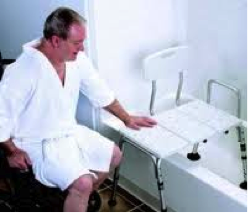 People who are recovering from a surgery; persons coping with the symptoms of a stroke, Parkinson’s disease or Multiple Sclerosis; or persons limited by weakness due to cancer or age-related problems will often rely on a technique called a ‘lateral-sliding transfer’ to move between surfaces. In other words, they scoot their bottom sideways to transfer from one surface to another, such as from from a wheelchair seat to a bath seat (see picture). Unfortunately the seat inside of classic-style “walk-in” tubs is blocked by a tall wall, making it impossible to slide sideways from a wheelchair seat onto the seat inside.
People who are recovering from a surgery; persons coping with the symptoms of a stroke, Parkinson’s disease or Multiple Sclerosis; or persons limited by weakness due to cancer or age-related problems will often rely on a technique called a ‘lateral-sliding transfer’ to move between surfaces. In other words, they scoot their bottom sideways to transfer from one surface to another, such as from from a wheelchair seat to a bath seat (see picture). Unfortunately the seat inside of classic-style “walk-in” tubs is blocked by a tall wall, making it impossible to slide sideways from a wheelchair seat onto the seat inside. 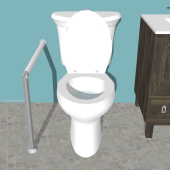
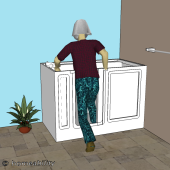

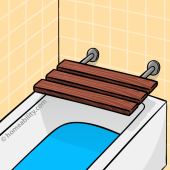
We purchased a walk in tub in 2018. It cost us over $14,000. It has been the biggest mistake of my life! First of all, we had to purchase a larger hot water heater.It takes so much water to fill these tubs that by the time we would get it full, we would be out of hot water and we would wind up taking a Luke warm bath at the most.I can’t remember without looking through my records, how much it cost, but the larger hot water heaters are quite expensive.I was the only one to use my tub and I always kept it clean. I went through the process of cleaning it as it said.I had this tub installed in June of 2018.I’m a very clean lady. I don’t have a lot of body oils or anything like that that would cause it to get extra dirty, and like I said I cleaned it as directed.I didn’t even use it that much because I found it very “ unhandy “. Even so I still cleaned in often just like they said.without looking up dates, I think it was the last part of December, 2020, I got in it and stayed about 30 minutes. The next morning I noticed that the front of both of my legs, the lower shin areas were red.By the next morning the areas had broken open and fluid was pouring out of them. I had to put small plastic bags up over my lower legs because I was poring fluid all over the floor.I got someone to drive me to the emergency room.I had to wait a long time. This was right about the time when COVID had gotten going really strong. I finally got to see the doctor. She said that normally she would admit me without hesitation, but they were having so much COVID that I was taking a big chance of contracting itI stayed, so she sent me home with antibiotics.I was taken back to another hospital two or three times and had all kinds of tests, bone scans to see if this was in the bones, IV’s, and more antibiotics. We had a lift chair at home because my husband was having health problems of a different kind at the same Time.I wound up having to sit in this lift chair for months without getting up at all. I had home health nurses come to my home every day and medicate my legs and change the bandages.By the time I was able to get up, I could no longer stand up straights and walk. I had lost 25 pounds.So for the last two years almost, I have been a prisoner in my on home. Up until this happened , I drove every day. I did everything that I had done all my life . I have been scared to death to use my walk-in tub. I can’t tell you the number of times I have gone through the process of cleaning the tub, but I just cannot make my self use it. I’ve had to rely on sponge baths.which brings me to this morning. I went into my bathroom this morning to prepare for cleaning the tub and to make myself get in it. I was rinsing it out, about to fill it with water to clean it and when Closed the stopper up and then went to open it to drain the rinse water out the mechanism broke. Well what would I do if I got it cleaned and then got in it to bathe and after filling it with me in it and then couldn’t get it drained because it was broken what would I do’ You can’t open the door if it’s full of water because it open’s in and I could not reach down to the bottom of the tub and manually pull the mechanism open because I wouldn’t be able to reach that far. It was a piece of plastic that broke off.I’ve dealt with one thing after another with this tub and I’m ready to do something about it. My husband and I had had our own business, a furniture store and had just retired when everything seemed to go wrong. He was diagnosed with cancer at the same time I was going through this ordeal with my legs. He passed away, not from the cancer, but from a medication he took for the cancer . It caused him to have autoimmune encephalitis. He passed away April 28th, 2021.
Thank you so much for sharing this information! We have been looking into getting a walk-in tub; two actually, one for my husband and me – we’re only in our 50s but I’m semi-disabled from peripheral neuropathy – and the other for my parents who live with us in the winter. I hadn’t considered any of these warnings other than having to sit naked waiting for the tub to fill and drain, especially the danger of being stuck inside potentially having fallen off the seat! What a terrifying thought! I’m going to share your article with my parents and see what they think before proceeding.
Bathrooms above other water damageable rooms, particularly in multiple floor/unit buildings should be designed with an additional drain that is always open in the center of a sufficiently sloped floor involving tubs, showers, and sinks. The bathroom wall/floor intersection should be caulked to a reasonable height to direct water to the drain. This would mitigate serious damage from various leak sources, especially and particularly walk-in tubs. I find it hard to believe that walk-in tubs are not much more adequately regulated, particularly regarding the elderly and multiple floor/unit buildings. Unfortunately, this well written article is NOT representative of glaringly deficient sales literature for walk-in tubs. I speak as a high-rise condo victim of a slippery, negligent walk-in tub unit-owner above and an uncaring association below.
© 2021
Thank you for taking the time to share your experience with others. We are sorry you are stuck coping with the ramifications of someone else’s walk-in tub! Hopefully your comment will help to deter person’s from installing a walk-in tub in multi-unit housing facilities.
You are correct. The article above does not address the sales tactics used by walk-in tub sellers. We have tackled the sales tactics in two other articles posted on our website, which are visible at the links below:
Walk in Tubs: Buyers Beware!
Walk in Tubs: Potential Hidden Costs
If your neighbor lives alone, it would be good to alert them that people can and have passed away inside of this type of tub due to slipping while inside of it & then finding themselves trapped on the floor, unable to get out.
We had a guy who talked us into a tub. So we mentioned it to our Dr she came uncorked. She said people who have high or low BP or Pace makers this is very dangerous for them. I causes lot’s of problem with your health. I told her the salesman said they installed them in the hospital,.she called BS on that they use whirlpools and are monitored.I did stop the check which they charged us for $16,450 . I’m glad I stumbled onto this site. Please be care of this . I alsocaused my husband bp to go up an caused his legs and feet to swell and was almost for two weeks. So be wary and ask your Dr before you buy
Do not buy a walk in tub . There is nothing safe about them .You think you will be relaxing like the commercials show you, wrong !
I have no problems with mobility, but was interested in a walk-in tub for therapeutic reasons, given medical problems with my neck, connective tissue and muscles throughout my body with a lot of pain. I noticed that hot jacuzzi tubs helped. I started looking for an alternative for my small downstairs bathroom, and had started designing my own therapeutic shower when I heard about walk-in tubs and invited a salesperson into my home today. His pitch was so convincing that I was sold. After reading this, I am convinced, as usual, that if it sounds too good to be true, it probably is! Thank you SO much, everyone, for setting me straight. I won’t make the same mistakes you have, so am very grateful that you shared your stories!
i am now a fulltime caregiver since my Fiancee had a stroke last May. Today we discussed getting her one of these. Thanks for pointing out the reality of this so well.
I have considered a walk in tubs for theropudic reasons and they’re depth and accessibility but after reading your points of consideration I’m having negative thoughts I have a standard tub but I also have a lift and the mai. Problem is how shallow it is I also would enjoy jets do you have any reamendations for a more enjoyable experience? That k you
THANK YOU ! for giving this common sense, in-depth advisement .. I, too, was considering a walk-in tub for a family member and now see the con’s related to such a marked investment .. the options you provide are with their own risks, but offer a more lucratively affordable and viable option worth trying .. especially the curbless shower .. ! I think I could build one of those myself .. ! (while I still can .. hah) in my 50’s here .. but still motoring on .. this article was just the information I needed .. thx agn !
Adding my own 2 cents. I would advise against a walk-in tub. I bought one for my Mom 5 years ago and she rarely uses it. First it takes 5 minutes to fill it up to the level she wants it and even with the optional power drain it takes 2 minutes to empty and my Mom doesn’t like waiting around.
Second its pretty common for walk in tubs to leak. First of all, you need to make sure that the seal and the area the seal touches are absolutely clean and smooth. You need to run your fingers around the seal and the place on the tub the seal touches to absolutely make sure there is no rough areas caused by dried soap scum, calcium or other minerals that are in most water. And even if these areas are absolutely clean and smooth, you have to make sure the seal is not dry – best to moisten the seal with a damp cloth or paper towel. Even so, it is still likely to leak a little although most walk-in tubs have a small drain at the bottom of the entry to account for this. Once the seal is thoroughly moistened, then leakage will either stop or trickle down to almost nothing. That is a lot of maintenance to do for a bath than most elderly people don’t like doing or are incapable of.
Most walk in tubs advertise lifetime warranties on their seals but read the fine print – you need to perform the maintenance I described above which I assume most people will not do. So that makes the warranty worthless.
Anyway, I dunno if you have noticed, but there aren’t much advertising for walk-in tubs these days and my Real Estate agent counted the walk-in tub as a negative when I decided to sell my Mom’s place after she decided to move in with my older sister. Admittedly I didn’t pay the outrageous 14k that it cost when these tubs first became available, but it still cost 3k for the tub, another 650 for the power drain and then I had to have a dedicated circuit run to it as well. Add taxes and installation it was well over 5k. Not worth it.
made the bigest mistake when I bought a Walk -in Bath tub. Its very uncomfortable and no satisfaction at all. I hope I can find someway to reverse my mistake and put back my tub into shower. I would like to know who can fix my problem.
Hello! Homeability is an informational website only. We do not provide contractor services. To our knowledge, the only recourse is to find and hire a local contractor who can help you to remove the walk-in tub and to install a new shower in its place. The only other alternative to consider would be: If you feel the salesperson that sold you the tub made false or misleading claims, which caused you to buy this tub that you believe does not live up to the claims that were made, you could potentially considering suing the company. The salespersons are usually trained by the company in what to tell a prospective buyer — so ideally the company (behind the salesperson) would be the one held responsible.
Of note, identifying an age-in-place experienced contractor is often not immediately easy to do, especially in smaller cities or towns. We do provide an article to assist people in identifying a local contractor with experience in making homes age-in-place ready. To learn more, visit: https://homeability.com/aging-in-place-how-do-i-find-a-contractor-2/
We also provide articles that identify some helpful things to take into consideration if do you opt to install a new shower. Of note, you have the option to have a new shower custom built from scratch or to install a prefabricated model. The cost can sometimes be similar, depending on your geographic location and your bathroom’s features, so it is good to ask the contractor you select, which option will be cheaper and/or better for your bathroom. The first article linked below discusses things to consider when building an accessible shower from scratch and the 2nd article discusses some things to take into consideration if you opt to purchase a prefabricated shower stall and have it installed.
1.Beginner’s Guide to Accessible Showers: https://homeability.com/accessible-shower-guide/
2.Benefits & Types of Prefabricated Curbless Showers: https://homeability.com/prefabricated-shower-guide/
Good Luck! We hope you are able to turn the current negative situation — into a positive one.
I’m so glad I came across this information before I decided to buy a walk in tub the misconception information just floored me guess I don’t have as much common sense as I thought. I have serious heart issues and if something happened while in the tub waiting either way wow I don’t even want to think it. But thank you for the information. Very helpful for me.
Rhonda, I don’t expect you to post my comments here but that’s Ok. I gave almost 10yrs experience in walk in tubs in the past. You bring up some valid points however some of your advice needs correcting. First of all, tubs now a days come with heated seats and backs.
Second of all, advising seniors to purchase a tub with an outward door shows me you have no real experience but you think you are an expert. Do you have any idea how much water weighs? Anyone who has common sense knows that much weight against an outward door will obviously leak, especially when the door seal dries out. And what if the senior accidentally opens the door. Major flood and major fall on a wet floor. You are no expert.
Hello! Your comment was flagged as being Spam by Akismet. I believe that it is valuable to post ALL comments that are are relevant to the subject at hand, regardless of whether they have been flagged as SPAM or not, because comments, such as yours, are helpful to open up a dialogue that allows people seeking information on this topic to determine for themselves what they believe to be relevant or not.
Yes. You are correct that an outward-opening door is more likely to leak over time, but the seal of an outward-opening door may need to be, and can be, replaced periodically, if needed. A Person’s life – cannot.
A person can become trapped inside a tub with an inward-swinging door for 2 reasons:
(1) A person is unable to release the water from the tub due to a drain or plumbing issue.
As you noted, the water pressure inside the tub is immense, amounting to several hundred pounds of pressure forcefully holding the door closed from the inside. Most older and mobility challenged persons would not be able to open the door, nor be able to crawl over the tub walls, so they would find themselves trapped inside.
(2) A person can also slip and fall while inside the tub.
A person who cannot get up from the bottom of a regular bathtub (which tends to be the type of person who is enticed by this type of tub) is also unlikely to be able to get up from the floor of a walk-in tub. To make matters worse, once someone is on the tub floor, their body effectively creates a wedge blocking the inward-opening door from being opened, thereby making it impossible for family or rescue personnel to open the door. This in turn means family or rescue personnel are required to crawl over the tub walls and find some way to lift a person from the cramped, footwell – putting everyone involved at risk of injury.
Examples of people who have experienced entrapment issues in walk-in tubs with inward-opening doors are visible at these links:
1. 90 Year old woman gets stuck in walk-in tub with an inward-opening door: https://wjla.com/features/7-on-your-side/90-year-old-woman-gets-stuck-left-to-bail-out-water-after-walk-in-tub-doesnt-drain
2. An elderly man fell and drown in the bottom of his walk-in tub with an inward-opening door: https://www.click2houston.com/news/jacuzzi-tubs-pose-safety-concern-for-elderly
3. A woman was trapped in the bottom of her walk-in tub with an inward-opening for several days before being found. She died days later due to complications related to being stuck 3 days with no food, medications, or ability to move herself: https://richardharrislaw.com/jacuzzi-walk-in-bathtubs-a-death-trap-for-the-elderly/